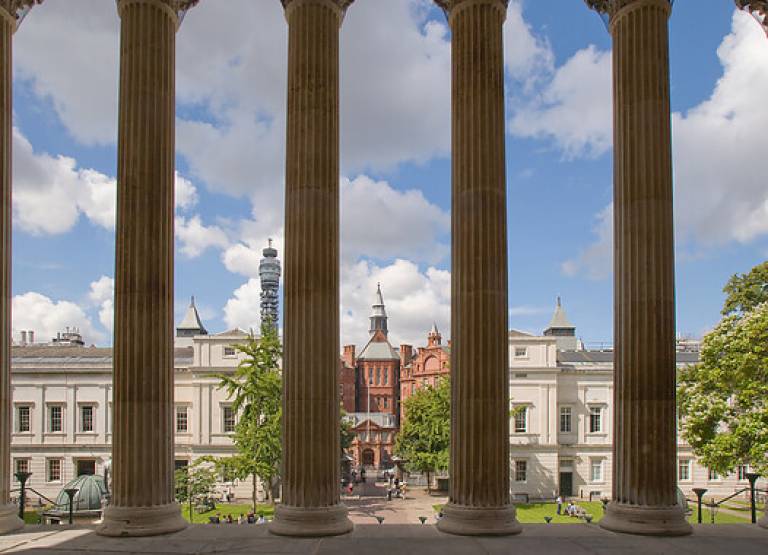Chemistry Light and Dynamics Group Seminar
15 November 2021, 3:00 pm–4:00 pm

Controlling Excitons in 2D
Event Information
Open to
- UCL staff | UCL students
Availability
- Yes
Organiser
-
CLD committee
Location
-
Virtual20 Gordon StLondonWC1H 0AJ
An exciton is a quasi-particle consisting of an electron and a hole bound by the Coulomb potential. It is a solid and excited state analog of the hydrogen atom. At interfaces of 2D semiconductors, such as transition-metal dichalcogenide (TMDC), moiré pattern formation and site-specific interlayer hybridization result in a periodic potential which serve as 0D potential traps for the 2D interlayer excitons. Moreover, 2D excitons can couple strongly to other degrees of freedom, such as phonons and magnons. In this lecture, I will discuss two research projects: 1) phase transitions of moiré excitons in the MoSe2/WSe2 heterojunction and 2) magnetic control of interlayer excitons in a 2D layered antiferromagnet (AFM) semiconductor, CrSBr.
In the first story, we establish moiré excitons in MoSe2/WSe2 heterobilayers and show their sensitivity to local strain, from 0D quantum dot arrays to 1D quantum wires. With increasing density, there are two distinct phase transitions: from trapped excitons in the moiré-potential to the exciton gas and to the charge separated electron/hole plasma. We explore the ordering of interlayer excitons into quantum phases using a WSe2/MoSe2/WSe2 trilayer structure and show evidences for the formation of staggered dipolar exciton crystals and droplets, symmetric quadrupolar exciton crystals, and ordered moiré trion lattices.
In the second story, we discover the coupling of 2D excitons to magnetic order in CrSBr. Excitonic transitions in bilayer CrSBr and above is abruptly modified when the magnetic order is changed from paramagnetic to AFM as T is lowered below the Néel temperature of ~140 K as it is switched from AFM to the field-induced ferromagnetic (FM) state. The magnetic-excitonic coupling is attributed to the spin-allowed interlayer hybridization in the FM, but not AFM state. This magneto-exciton coupling allows the detection of coherent magnons. We launch the spin waves from across gap excitonic transition and detect the spin waves from oscillations in exciton energies. We discuss the prospects of using these optically accessible spin waves as quantum interconnects.
- Jue Wang, Jenny Ardelean, Yusong Bai, Alexander Steinhoff, Matthias Florian, Frank Jahnke, Xiaodong Xu, Mack Kira, James Hone, X.-Y. Zhu, “Optical generation of high carrier densities in 2D semiconductor hetero-bilayers,” Science Adv. 2019, 5, aax0145.
- Fang Liu, Wenjing Wu, Yusong Bai, Sanghoon Chae, Qiuyang Li, Jue Wang, James Hone, X.-Y. Zhu, “Disassembling 2D van der Waals Crystals into Macroscopic Monolayers and Reassembling into Artificial Lattices,” Science, 2020, 367, 903-906.
- Yusong Bai, Lin Zhou, Jue Wang, Wenjing Wu, Leo McGilly, Dorri Halbertal, Chiu Fan B. Lo, Fang Liu, Jenny Ardelean, Pasqual Rivera, Nathan R. Finney, Xuchen Yang, Dmitri N. Basov, Wang Yao, Xiaodong Xu, James Hone, Abhay Pasupathy, X.-Y. Zhu. “Excitons in strain-induced one-dimensional moiré potentials at transition-metal dichalcogenide heterojunctions,” Nature Mater. 2020, 19, 1068-1073.
- Jue Wang, Qianhui Shi, En-Min Shih, Lin Zhou, Wenjing Wu, Yusong Bai, Daniel A. Rhodes, Katayun Barmak, James Hone, Cory R. Dean, X.-Y. Zhu, “Diffusivity Reveals Three Distinct Phases of Interlayer Excitons in MoSe2/WSe2 Heterobilayers,” Phys. Rev. Lett. 2021, 126, 106804.
- Kihong Lee, Avalon H. Dismukes, Evan J. Telford, Ren A. Wiscons, Jue Wang,Xiaodong Xu, Colin P. Nuckolls, Cory Dean,Xavier Roy, X.-Y. Zhu, “Magnetic Order and Symmetry in the 2D Semiconductor CrSBr,” Nano Lett. 2021, 21, 3511-3517.
- Nathan P. Wilson, Kihong Lee, John Cenker, Kaichen Xie, Avalon H. Dismukes, Evan J. Telford, Jordan Fonseca, Shivesh Sivakumar, Cory Dean, Ting Cao, Xavier Roy, Xiaodong Xu, X.-Y. Zhu, “Interlayer electronic coupling on demand in a 2D Magnetic Semiconductor,” Nature Mater. 2021, 20, 10.1038/s41563-021-01070-8
About the Speaker
Xiaoyang Zhu
at Columbia University, New York
 Close
Close

